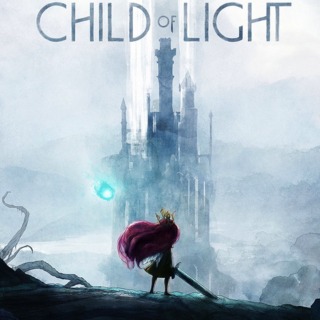Child of Light is very visually appealing, using the UbiArt engine just like Rayman Origins and Legends. It features a hand-drawn art-style with watercolours, and really nice animations like the flowing hair of the protagonist.
Another distinctive aspect is the poetic dialogue; but the inconsistent rhyming patterns seems odd to me. It has a fairytale story, and just like a lot of those stories, it has a dark set-up with the young girl Aurora dying, but transported to a fantasy world called Lemuria.
Aurora has a firefly partner which you control with the right-stick. He can open certain chests, interact with puzzles in the world, illuminate darkness, can heal you, and collect the magic to replenish his energy or your HP/MP. He can stun enemies so you can get in behind them. In battle, he can slow 1 enemy down.
The battles are Turn-based RPG but with active time. There is a timeline at the bottom of the screen which shows each character’s turn time. Once it reaches the cast section, you can then choose an attack. Each attack takes a set time to execute. If you are attacked whilst you have an attack pending, then you are interrupted and are pushed back on the timeline (so you will get another chance to attack quickly).
The battles are often 2 versus 3, so you are often at a disadvantage. When you are against a tougher enemy, or enemies that can respawn allies, then these battles get drawn out. If enemies slow you down or cast haste of themselves, you are at a massive disadvantage. You can end up being attacked 6 times before you can hit once, and even then you may end up being interrupted. Enemies always have an elemental weakness which you can exploit.
When initiating battle from the world, you get the advantage if you move into the enemies from behind, but will be at a disadvantage if the enemy has charged at you, or hit you with a projectile.
Leveling up is quick, often every battle or two; so it is worth attacking all enemies to maintain your strength compared to the enemies. The bad news is that you then spend a lot of time in the menus since you need to spend your points. There’s not really much of a choice with the skill trees, since there’s basically 3 linear trees so I’d imagine most people will choose one and complete it before moving onto the next. Each slot may just boost stats, give you new powers, or passive abilities.
You are on your own for a bit, but then find another party member. As you go through the chapters, you find more characters and these can be switched out - and you will need to. Sometimes this is because you have depleted their magic or have low health, or you may switch out for tactical reasons since each party member is distinctive.
As rewards for battles or opening chests, you acquire Oculi gems. There are a few different colors to find, and these can be combined to form new colours, or stronger variations. A Ruby and Sapphire gives you an Amethyst. Combining 3 of the same colours gives you 1 stronger version. These Oculi can be equipped to 3 slots on the character. The Weapon slot mainly gives you elemental attack, Armour slot gives you defense, Trinket slot gives you different effects. It’s a good idea to switch out Oculi to gain elemental advantages in each area.
Early on there’s platforming and moving blocks to progress. You soon discover a flying power, then you pretty much always fly around. There’s some simple puzzles early on but then become more sparse as the game progresses. They often consist of shining light to match symbols on a wall.
The game takes around 12 hours which is quite short for an RPG, although I did start to feel a bit bored near the end. I played on the harder difficulty and I felt that most battles required thought to be able to win; which is a major plus point given that most RPG’s feature mindless battles. It would have been nice to be given more interesting puzzles because most of them felt like I was just hitting switches.

